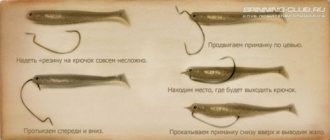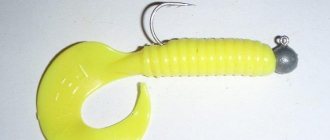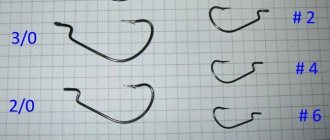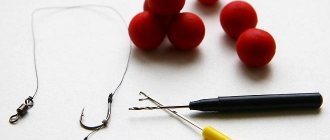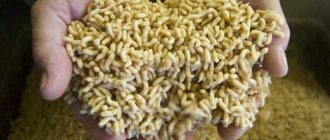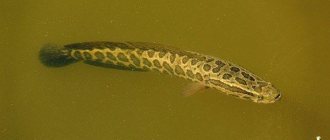Or maybe I don’t understand something... but for proper installation, the body of the bait must be very high.
Due to my line of work, I have to communicate quite often with different fishermen...
And from conversations I am surprised to understand that quite a large number of people still do not know how to properly mount bait on an offset hook.
It would seem that there is so much talk about offset hooks, so many articles... but if you think about it, I haven’t seen a simple article with photographs on how to properly put a bait on an offset hook.
Well, let's fill this gap. Below is my personal opinion regarding the offset topic. I don’t insist on 100% coverage of this topic, I’ll just share my personal experience.
Offset hooks - a brief theory on offset hooks.
“Ofsetnik” is Russian fishing slang. Derived from the English “offset hook”.
Basically, rubber (silicone baits) - twisters, vibrating tails, etc. - are mounted on offset hooks.
Here is a classic view of a mounted bait on an offset hook (don’t remember, the mounting is incorrect)
The task of the offset hook is to ensure the installation of soft bait in a non-snaking version. That is, it is “unhooked” for baits.
Offsetters have problems with fish detection.
Many people criticize offset hooks :
— Some fishermen DO NOT catch snags, but they don’t catch fish either
- and for some, on the contrary, there are solid hooks.
In fact, if you mount the offset hook correctly, you will catch the fish “as it should” - you rarely catch snags, but you accurately catch the fish.
Step #3.
We try on the puncture site as shown in the photo.
Step-by-step photo instructions
Very simple and useful instructions that even a beginner can understand. The entire installation process will be shown using a simple twister as an example.
Step #1.
The first thing to do is to pierce the bait from the end, and bring the point of the hook inward at an angle of 90 degrees.
In the end it should look like this.
Step #2.
The bait, in this case a twister, needs to be pulled to the base of the hook.
Step #3.
We try on the puncture site as shown in the photo.
Step #4.
We bend the bait and pierce it. The puncture must be made perpendicularly, as shown in the photo. Straighten the bait so that the point of the hook runs along the body of the bait.
Well, is it simple and clear? Other types of silicone baits can be equipped using a similar scheme.
Expert advice
Ivan Sharapov, Candidate Master of Sports in Fishing, NSO:
- How do you know if you did everything right? I'll give you a couple of tips that I heard from my mentor a few years ago. The essence is very simple and clear. To begin, after rigging the hook, run your finger along the body of the bait where the hook came out. The finger should not cling to the tip. This is necessary so that the equipment does not cling to obstacles in the water column. However, remember, you CANNOT stick a point into the body of the silicone! Since when there is a bite, it will be almost impossible to hook the fish...
The second point is pressing on the body of the bait, at which it should bend slightly. This is necessary so that when biting the fish does not feel resistance and calmly “attacks”.
Thus, we get a virtually non-interfering installation of the silicone bait with the offset tool. But when the fish bites, it’s easy to press on the silicone, and the sting immediately comes out. Accordingly, the hook follows, and the fish sits securely on the offset hook.
How to attach a silicone bait to an offset hook
Using the example of the Akara Eatable Best Shad , you can demonstrate how to equip it with an offset hook. The bait has a slot at the bottom of the body so that the offset tool has free movement, and a groove on the back to recess the offset tip.
Photo 2. Groove on the back of the bait
Photo 3. Slot at the bottom of the bait
How to choose an offset hook for a silicone bait . The offset should not exceed half the body of the bait (Photo 4. 1). In this case, the bait has a length of 90 mm; an offset machine with number 2.0 is perfect for it. These are Maruto offset hooks (Maruto Spin Pro 1957 series) - quite thick wire and a sharp sting. The bait is pierced from the head (2) and placed on this step, which is located near the offset eye (2-4).
Then we try on where the offset press tip should come out (5-6), and make a puncture from below (7), bring the offset press tip out not strictly across, but slightly shift it towards the head (8) so that the offset press tip goes diagonally a little diagonally. This way the offset press will hold up much better.
Photo 4. How to put silicone on an offset hook.
Let us note once again that the bait has a groove on its back. Here the sting of the hook is hidden in it (1-2). But you can further (slightly) recess the tip of the hook and bring it out, pressing it even more towards the back (3).
Photo 5. How to additionally drown the offset press tip
Thus, we get a virtually non-interfering installation of the silicone bait with the offset tool. But when the fish bites, it’s easy to press on the silicone, and the sting immediately comes out. Accordingly, the hook follows, and the fish sits securely on the offset hook.
Photo 6. When you press on the silicone bait when biting, the sting immediately comes out.
Here you still need additional loading. Most often, this is an ordinary collapsible Cheburashka. We disassemble it, put it in the ring and put the Cheburashka back on.
[THERE IS AN ANSWER] How to put a double on a silicone bait?
Photo 7. Loading with Cheburashka.
Our installation of silicone bait with offset hook is ready.
Thus, by varying the size of the Cheburashka, its weight, we can select the bait, the same bait, for different fishing conditions, for different depths and current strengths. Just changing the Cheburashka.
Earlier, we said that in order to securely fix a soft silicone bait on an offset bait, a plastic retainer is required, which will not allow the bait to slide off the hook after idle bites, pulling through algae, etc.
Earlier, we said that in order to securely fix a soft silicone bait on an offset bait, a plastic retainer is required, which will not allow the bait to slide off the hook after idle bites, pulling through algae, etc.
In addition, fixing the bait prolongs its life, preventing it from breaking at the head attachment point. This is especially true when using soft rubber.
Stopper
It was proposed to use half of a cut float stopper as a retainer, as in the photo above.
I still think this is one of the most convenient methods, but it does have the downside that some of the stoppers break when threaded onto the hook.
Spring retainer
Another well-known method is to screw a spring corkscrew into the head of the bait, into the ring of which a hook is threaded.
Both of the methods described above are good, but thanks to the readers of the channel, several more were found. The most interesting, in my opinion, are described below.
Plastic retainer
The plastic keeper (final keeper) is even easier to install than the spring keeper.
Sequins
Sequins are discs with holes for decorating clothes and other products. To use as a fixative, you need to choose the smallest sequins with a diameter of 3-5 mm with a thin hole.
To fix the bait, the disk is threaded onto the hook, like half a stopper in the first method.
Plugs for studs
Plastic or silicone stud plugs are another option. This is even better than sequins or halves of a float stopper. You just need to put it on the hook and that’s it.
Some anglers have suggested using “superglue”, but to me this method seems the least practical.
Did you like the article? Subscribe to the channel to stay up to date with the most interesting materials
To firmly fix the silicone, you should take an offset press with springs . A spring is inserted into the body of the bait, which prolongs its life, preventing it from falling off the hook when attacked by a predator.
Installation of silicone on an offset hook
Non-snacking installation of silicone bait on an offset machine can be carried out in one of two ways.
The first option is the classic Texas one. Its use is envisaged in the presence of a conventional offset press with a straight bend. In this case, the silicone bait is pierced in the front part and fixed on the Z-shaped bend of the hook. The sting enters the body almost completely, but is not brought out. With this installation, the bait is protected from snagging to the maximum.
The second option is open installation, which involves the use of a Wide Gap offset printer. With this method, the offset tip is pressed very tightly against the body of the bait or hidden in a specially made groove in silicone.
In the case of jig equipment, the offset hook is connected to the eared sinker using a winding ring.
Advantages of offsets
The specific design of the offset machine has many serious advantages compared to an ordinary crochet hook. And this is not surprising; for more than a century, its design has been constantly refined and improved.
The main advantages of silicone baits on an offset hook:
- excellent cross-country ability and minimal grip;
- the ability to choose the optimal offset for any soft bait from a huge variety;
- ease of installation, which even a novice spinning player without experience and deep knowledge can handle;
- reliability and durability of the product.
3. Attach a hook to the end of the leash.
Types of offset hook
Sickle Hook or crescent-shaped offsets were created for mounting jig heads. The difference from other species is the peculiar shape of the hook, made in the likeness of a sickle.
Advantages of this type of fishing hooks:
- reliability of bait attachment;
- holds fish well during fishing;
- self-cuts into the side of the prey's mouth.
Wide Gap – have a wide bend angle, which ensures fastening of solid bait. These hooks are also great for mounting shad type lures with a wide belly. An offset press with a wide bend angle is used with large or hard silicone.
Texas hook is a classic shape that was the first to appear on the fishing market. These fishing hooks have a straight bend. Unfortunately, this design feature of the Texas hook shape limits the angler in the use of some silicone baits. As a rule, narrow-bodied baits are attached to such hooks.
2.1 Loaded offset hook
This is a type of hook that belongs to the wide gap type of hook. Such equipment elements differ in that they have lead on the forend, which serves as a weight. As a rule, they are used in conjunction with jerks or swimbaits. May include installation with Cheburashkas.
A special feature of such loaded fishing hooks is the ability to cast long distances and engage in jig fishing in reservoirs rich in vegetation and shallow areas.
About the features of this hook, its advantages and installation, see the channel “Passion for Fishing”
2.2 Offset hook with spring
The advantage is the convenience and reliability of fixing the silicone. Along with these qualities, the bait will last longer, since on a regular offset hook, after N number of powerful bites, the silicone is damaged and becomes unsuitable for further use.
Installation of silicone baits on a retractable leash.
This is a fairly simple, universal method.
Sinker - any shape will do, but “Drop” would be better;
1. Tie a sinker to the end of the main line using any knot you know. You can watch a video about what they are and how they are knitted on our YouTube channel
2. Tie a leash 20 cm above the sinker.
3. Attach a hook to the end of the leash.
4. Place a silicone bait on the hook.
Advantages: equipping silicone baits with a retractable leash is good because it allows the bait to move smoothly and slowly sink to the bottom. This attracts passive and uncertain fish and pushes them to bite. In addition, this method allows you to cast long distances and fish in reservoirs with strong currents using heavier loads, which will not affect the quality of play of bait of any size.
Helpful Hints: The diverter leash can, if necessary, be upgraded for difficult conditions. If there is a passive fish in the reservoir, then it is better to lengthen it.
If the pond is too snaggy, then use an offset hook, so the bait will cling less often and better avoid obstacles when retrieving.
If you hunt pike, then for better results use a “double”. It will minimize the number of fish hatches and provide you with a good trophy.
In addition to the two main ways to rig silicone baits with an offset hook, there are the following techniques:
1. Drop shot. Simple, easy-to-catch equipment, suitable for any type of silicone bait. It works best when fishing from a boat, vertically, as well as on reservoirs with a rocky bottom. Provides fewer snags as the hook is fixed and located above the load.
The sinker is stick-shaped or pear-shaped;
1. Tie the hook to the fishing line so that it is perpendicular. The tip should be pointing upward. The Palomar knot will help here.
2. Attach a sinker to the end of the fishing line. The distance from the sinker to the hook should be approximately 15-20 cm.
3. Place the bait on the hook.
Advantages: The bait on such equipment is well controlled, since any bite is immediately transmitted to the rod.
2. Jig-rig. Equipment originally developed for catching overseas bass. But it turned out to be quite applicable for domestic pike perch, perch or pike. Similar to a drop shot, but here the load is secured independently. You can unfasten and change the weight, adjusting it to the conditions of the reservoir.
1. A cord, a silicone bait on an offset hook and a sinker on a swivel are attached to the central winding ring.
2. Instead of a central winding ring, a leash with a carabiner attached to a cord is used, onto which a hook with silicone and a weight on a swivel are placed.
[THERE IS AN ANSWER] How to attach a silicone bait to a jig head?
Advantages: it is universal and can be used with any type of silicone baits, and when using an offset hook, the permeability will improve.
3. Texas rig. Great for fishing in places with a lot of vegetation, snags and various obstacles on the bottom. The equipment is almost not afraid of branches, stones, or algae and bypasses them better than other types.
1. Thread a stopper and a weight onto the main line so that the pointed part “looks” towards the rod.
2. Put on a silicone shock absorber or bead.
3. Tie the hook to the fishing line.
4. Place the silicone bait on the hook.
Advantages: effective when fishing in hard-to-reach places; the shape of the sinker and bait allows it to bypass obstacles and almost not cling to grass or tree branches under water. It is universal and can be used with any type of silicone baits.
Features: you can increase the distance from the weight to the bait, which allows you to work more freely when falling and look more appetizing to the fish.
It will be most effective with an offset hook.
4. Carolina rig. This is a variant of the modernized Texas one. It differs in that a swivel is attached after the weight and stopper. This allows you to replace only the leash with another one if necessary or in case of a break, rather than re-tying the entire rig.
That's all! It is very easy to put silicone on the offset hook! A few training sessions and you'll be making these types of rigs in a matter of seconds.
The offset hook has taken root firmly among spinning fishermen. Modern jig is unthinkable without it. The peculiarity of this hook is its special shape. When equipped with a silicone bait, the tip of the hook is pressed against the back of the bait, which ensures excellent passage through various underwater obstacles.
Hooks of this type are indispensable when fishing in areas with snags, grass, bottom debris, and stones. Each offset hook model is designed for one or another silicone bait. The deeper you pry the offset, the more voluminous the bait can be equipped. Hooks with this hook have the Wide Gape prefix. For worms and slugs, it is customary to use more elongated models with a low hook. In the catalog of many manufacturers you can find options with loading, springs, swivels for drop shots and others.
It is necessary to choose an offset hook in such a way that the sting comes out approximately in the middle part of the bait. If you are tormented by idle bites “by the tail,” you can increase the length of the hook.
Installation of the non-hook paired with this hook is very simple and easy to assemble. The best way to rig a bait:
- Choose the hook size you need
- Place the hook against the bait and remember where it should come out from.
- Pierce the head part of the bait and remove the sting (you need to pierce quite a bit, with a slight slope)
- Pass the bait through the entire hook, unfold it and place it on the step (the part between the shank and the eye)
- Let's see where the hook will come out
- We pierce and remove the sting into the dorsal part
That's all! It is very easy to put silicone on the offset hook! A few training sessions and you'll be making these types of rigs in a matter of seconds.
In more detail, you can watch the video from the author Fishing with SIBIRYAK'007
This soft bait design can be used:
General principle and advantages of offset hook
The design of the offset hook is somewhat different from the design of a regular hook and is characterized by the presence of a step near the fastening eyelet, smoothly turning into a bend. This bend makes it possible to securely attach the silicone bait. The step prevents the bait from sliding off the hook and does not interfere with its active play when retrieving.
Using different fastening options, you can get either a regular bait with an offset hook, or a non-hooking bait, which makes it possible to fish hard-to-reach places: areas with aquatic vegetation and places with snags and branches.
The use of an offset hook has absolutely no effect on the performance of a particular bait. The offset hook is selected depending on the following conditions:
- Type of bait. It could be an ordinary fish, a twister, a worm, etc.
- Silicone bait sizes.
- The thickness of the silicone bait.
Currently, manufacturers of silicone baits provide special grooves that allow the use of offset hooks without any problems.
- We pierce the head of the bait through the offset eye;
- put a stopper through the tip;
- hide the forend in the body of the twister.
What does an offset hook consist of?
An offset hook or offset hooks (translated from English as “displaced hook”) is one of the types of “barbed” elements of spinning equipment, which has a zigzag-shaped bend in its design, popularly called a “step”.
The main structural purpose of the “step” is the strength of holding the silicone bait on a fishing hook and the non-snaking of the hook when fishing in hard-to-reach places in the reservoir.
An interesting feature of the offset hook is that when using silicone in jig fishing, when it gets into the mouth of a fish, it does not suspect that it is already “on the hook”, thanks to the design uniqueness of this fishing hook.
The offset hook is the result of the inventive activity of one of the US residents, who in the 20th century came up with such a fishing “squiggle” for the purpose of reliably fixing a plastic worm on a hook. Then Texas fishermen put the innovation to use and came up with a classic offset rig called the “Texas” rig.
The original classic shape of the “offset” fishhook was like this
Over time, the equipment for jig fishing has undergone changes and has various modifications, which will be discussed below.
- “a” - the segment from the ring to the step allows you to assess the depth of insertion of the hook into the head of the bait;
- “b” “step” , which determines the possible thickness of the bait’s head;
- “c” “forend” is the straight part on which the size of future production depends. So, for example, for jig fishing in a freshwater body, select a hook with a shorter shank than for sea jigging;
- “g” “hooking” is the part of the bend of the fishing hook that holds the prey after hooking it. Hoods come in various shapes: rounded or angular. The difference is that the angular hook allows the hook to penetrate deeper into the mouth of the prey. A rounded hook is considered more durable;
- “d” “sting” is a sharp part that serves to pierce the lip of prey. The quality of the hook depends on the degree of sharpness of the sting. The design of the sting includes a barb (notch), which ensures a tight grip on part of the fish’s pharynx.
1.1 Hook step shape
The shapes of modern offset hooks come in two types:
- The shape in which the sting fits or fits into a special hole in the bait, provided for by the design features. A step in this shape has a zigzag appearance (see Figure 2)
- The shape is in the form of a step, bent twice at an angle of 90 degrees (see Figure 1).
It is believed that the first option with a Z-shape is reliable in attaching bait.
1.1.1 Forend of offset hook step
When choosing a bait, the length of the shank of the step of the offset hook matters. Silicone worms and bulk baits are easily attached to the elongated part of the hook element.
1.2 Offset hook tip
There are two types of position of this part of the hook in relation to the step:
- at an angle;
- parallel.
The sting, located “at an angle”, is aimed at the back of the bait. The advantage of the angular location of the tip is that the percentage of engagement with unnecessary piles in the reservoir is reduced. Disadvantage : the number of prey bites decreases.
The “parallel tip” is not directed at the corner of the step, but runs parallel. With this arrangement, the chances of a successful bite are many times higher, but the chances of catching something unnecessary in the pond also increase. To install the “non-hook”, fishermen hide the tip in the back of the silicone.
Option 1
Option 2
Offset hooks with a sting shape similar to option 1 are used for voluminous (thick) baits, such as crustaceans, vibrotails, octopuses, etc.
The second type is suitable for thin-bodied silicone baits: twisters, slugs, twintails, worms, thin-bodied vibrotails, etc.
You can read more about such silicone bait as twister here
Find out about the features of the artificial silicone octopus nozzle here
Installation of baits
Installation steps for silicone nozzle:
- we pierce the head and remove the sting at 6–9 mm, from the side of the abdomen;
- we stretch the sting through the fish, all the way to the mounting eye;
- We measure the entrance of the sting into the silicone body with our eye;
- We pierce the abdomen and remove the sting from the back area.
In this form, it can be secured: to a sinker - a Cheburashka, a retractable leash, or the main fishing line.
Fixation method using TWIST LOCK. This is a special spring; it is wound around the central wire of the hook. This type of attachment is especially useful for very soft baits.
To secure silicone with offset machine and TWIST LOCK fastening, you need:
- We screw the head part onto the ready-made mount;
- then we pierce it through the body, hiding the tip.
Fastening for a braided leash - if the offset machine is located on a leash with rigid equipment, and it will be difficult to remove it then:
- We pierce the head of the bait through the offset eye;
- put a stopper through the tip;
- hide the forend in the body of the twister.
Vibrating tail installation
- Pierce the end of the nozzle with a hook to a depth (0.6–0.8 mm), bring it out through the stomach, but only so that only the tip peeks out.
- Place the hook on the back , try it on so that you can determine the location of the future puncture and the angle at which the sting should penetrate into the silicone body of the bait used.
- Pierce the belly of the nozzle with a sting at the marked angle , and bring it out on the other side of the back.
- Check the fixation strength.
[THERE IS AN ANSWER] How to choose an offset hook for a silicone bait?
When installing soft bait, you need to pull it a little so that it does not slip. This attachment can be used: with a side outlet, or with a “eared” sinker.
Twister installation
- We begin piercing from the center of the nozzle, with a distance almost equal to the total length of the step and link.
- We pass through the body of the twister to the hook, up to the step. Then we pull the bait into the extension link.
- Insert the tip of the sting into the dorsal part of the nozzle and bring it out near the tail.
- We fasten the sinker with the eye with a winding ring.
- Checking the fixation.
Installation of offset hooks
- Non-hooking baits mounted on an offset machine are able to pass through thickets of aquatic vegetation and snags.
- Offset hooks are used by fishermen for movable mounting of bait.
- Offset machines are used in different types of rigs (Texas, Moscow, Carolina, drop-shot) .
